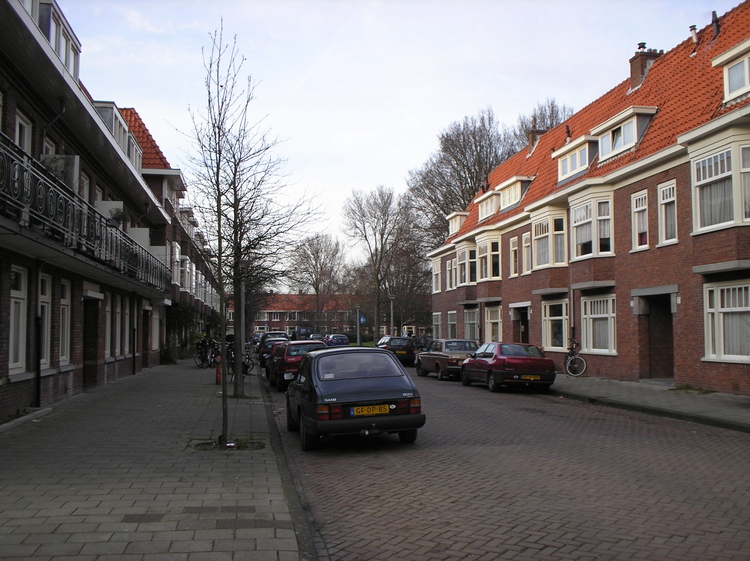De deur van de achterkamer zoeft open. Ja, daar is de zwart marmeren schoorsteenmantel. In de oorlog staat het wonderkacheltje met een lange pijp, een heel eind de kamer in. Als je te dicht bij het ronde kacheltje zit, krijg je allemaal aardbeien op je benen. Ik heb een keer een grote blaar op mijn knie gebrand. Toch te dichtbij de kachel gezeten. De ingebouwde hoekkast klinkt hol als ik de deur opendoe. Alle verstelwerk, strijkgoed, het rieten paarse bloemenmandje met de bollen wol en de gele en rode Velasques sigarendoosjes, zijn eruit. Zouden de gladde blikjes in de nieuwe kast ook altijd zo glijden en op de grond vallen? De glazen schuifdeuren tussen de voor- en de achterkamer bommeren hard over de rails nou de kamers leeg zijn. Ze zitten tussen de kasten ingeschoven. Nooit kan je meer iets achter dat rode stuk glas houden en kijken hoe het helemaal anders lijkt.
Waar zou pappa in het nieuwe huis de familiefoto’s nemen? De erker met zijn twee schuiframen en een groot raam is lekker licht. ‘s Middags schuift mamma daar altijd het linker raam omhoog. Zij tikt op de ronde broodplank. Ja, daar komen de meeuwen eraan vliegen als zij de fijngesneden broodkorstjes hoog de lucht ingooit. De meeuwen duiken van alle kanten op het brood af. Geen één huis heeft een mamma die zo de meeuwen roept! En de glazenwasser met zijn lange ladders die de bovenramen komt zemen. De houten ladders worden met een harde klap uit mekaar geschoven en tegen de vensterbanken gezet. Ineens verschijnt er een hoofd en dan een bovenlijf voor de ramen. De ramen zitten vol waterdruppels. Een houten stokje met een rubbertje wordt over de natte ramen geveegd. De emmer bengelt aan de trap. In de lijfband zitten al zijn schoonmaakspullen. Als hij klaar is, tikt hij tegen het raam. Het raam wordt opengeschoven en hij krijgt zijn geld. Het raam wordt dichtgeschoven en de glazenwasser klimt de traptreden weer af met de emmer water in zijn hand.
Wat voor plakkaat zal er nu met de verkiezing voor dat zijraam hangen? Mamma vecht haar enige stille burengevecht met de verkiezing. Met trots en een triomferende lach wordt het papier tegen het glas gehangen: ’De mensen moeten weten waar je voor staat’, zegt zij. De naam van de politieke partij staat erop. Het licht op de divan is, nu een tijdje voor de verkiezing, doffer. De buren hangen ook papieren met andere partijnamen- CHU, P.v.d.A., in plaats van AR.
‘Ik kom nou. Ik ga nog even naar boven’, roep ik. Nu de trap op naar de slaapkamerverdieping. Op de overloop bij de slaapkamers maak ik altijd tenten van lappen. Het zolderkamertje zonder raam is links aan het einde van de overloop. De kolenhandelaar brengt ieder jaar de groene papierzakjes antraciet naar het zolderkamertje. Ik kijk nog een keer door de dakvensters op straat. Onze slaapkamer is op twee hoog en de straat is ver beneden mij. Het loden dak platje lekt niet meer. In de oorlog is er geen lood en de loodgieter maakt elke keer provisorisch de dakgoot. Iedere keer moeten de pannen bij een volgende regenbui weer in de erker worden gezet. ‘Pets, pets, pets, pang’, vallen de druppels op de aluminium bodems.
Het Engelse bed met de witgeverfde spijlen is weg. De papieren met de appels onder het bed zijn er ook niet meer. ‘s Winters moeten elke week de appels, de Cocks-oranges en de Goudreinetten ‘een slagje om’ gedraaid worden. Een raar gezicht die appels onder de bedden en dat beddestof wat ook weg moet. In de andere twee slaapkamers hangen alleen de koordjes om het licht mee aan te doen.
Ik doe de badkamerdeur open. ‘Knip’, zegt de schakelaar. De oranje Junker geyser met zijn geriffelde buitenkant hangt aan de muur. Het bad staat op zijn gewone plek. De witte tegels met de zwarte smalle randjes, glimmen in het lamplicht. De houten wringer met bok, waar mamma de gekookte was doordraait, staat er niet meer. ‘Ik kom hier nóóit meer terug’, besef ik ineens. Ik kijk in de spiegel. De witgrijze marmeren plaat met de chroomreling is leeg. Alle tandenborstels en het ovalen tandpastablikje zijn weg. De kranen zitten doodgewoon op hun plek. Zij blijven ook op hun plek. Zij zijn niet verschoven of geschud door de verhuizing. Andere mensen zullen de kranen opendraaien en in deze spiegel kijken om hun haar te kammen. Wat moet ik nou doen om afscheid te nemen van ons huis? Ik geef de spiegel een zoen. Ik loop de badkamer uit, door onze slaapkamer, links over de overloop, de trap af, de andere gang in en de beneden trap af.
Oom Jaap en de hond zitten al te wachten in de cabine van de verhuisauto. Ik stap op de treeplank en ga op de hoge zitplaats zitten. De motor ronkt en de verhuisauto schudt. De hond jankt. De buurkinderen staan op straat en wuiven. Wij wuiven terug.
‘Dag huis’.
24 februari 1948
Lees ook:

